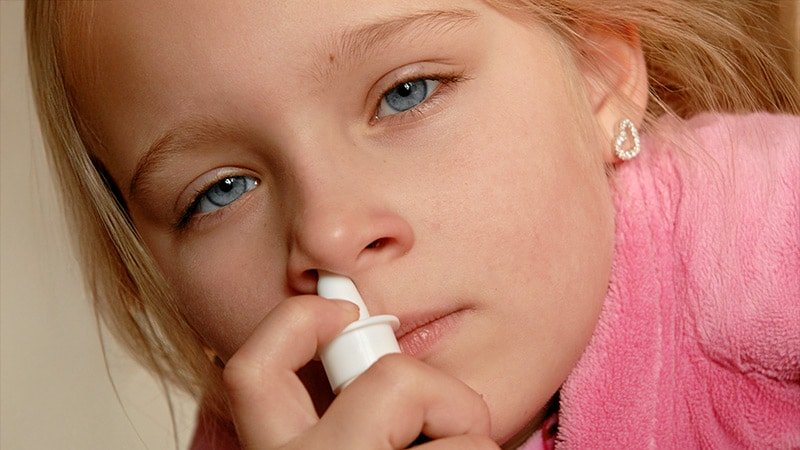For children with allergic rhinitis, access to over-the-counter (OTC) treatments has never been broader — or more effective. From nonsedating oral antihistamines to intranasal corticosteroids, families now can begin allergy management at home, often without stepping foot in a clinic.
Although access has improved, clinicians still play a critical role in guiding families through treatment choices, addressing hesitations, and identifying when it’s time for referral.
“At least 90% of patients I see have used OTC antihistamines and/or nasal steroids,” said Angela Hogan, MD, chair of the asthma committee for the American College of Allergy, Asthma, and Immunology and professor of pediatrics at Macon and Joan Brock Virginia Health Sciences at Old Dominion University in Norfolk, Virginia.
Cosby Stone, Jr, MD, MPH, assistant professor of medicine in the Division of Allergy, Pulmonary, and Critical Care Medicine at Vanderbilt University Medical Center in Nashville, Tennessee, called this shift “a democratization” of early allergy care.
“Patients can now do a kind of road test — trying a nonsedating antihistamine like cetirizine or loratadine — to see if their child’s symptoms are likely due to allergies,” said Stone.
This self-directed approach helps families take the first step and gives clinicians more information at the time of evaluation.
“If a parent tells me their child improved on Zyrtec or Allegra, that helps confirm we’re dealing with allergic rhinitis,” Stone said. “But if it didn’t help at all, it may be something else.”
Nasal Sprays: Effective but Underused
Despite the availability of intranasal corticosteroids over the counter, many families hesitate to give them to their children.
“Parents seem to always be more reluctant to use nasal steroid sprays than their allergy doctors are going to be,” said Stone. “Usually, they’ve tried an oral antihistamine first and only seek help when that doesn’t fully control the symptoms.”
Technique is equally important. Stone said that poor aiming of the spray often limits effectiveness.
“If you’re tasting it, you’re wasting it,” he said, advising families to angle the spray slightly outward toward the outer corner of the eye to reach the inflamed turbinates.
Knowing When to Refer
While OTC access has reduced barriers to care, it hasn’t eliminated the need for specialist involvement — especially in more complex pediatric presentations.
“If a child is still symptomatic after a good trial of intranasal steroids and antihistamines, that’s a clear sign it’s time to consider a referral,” Hogan said.
According to Stone, key indicators for referral include:
- Coexisting allergic conditions, such as asthma, atopic dermatitis, or eosinophilic esophagitis
- Persistent or severe symptoms despite appropriate OTC medication use
- Daily antihistamine dependence without adequate symptom control
- Sleep disruption or impaired functioning due to nasal congestion
- Concerns about medication side effects or long-term use
“When allergic rhinitis is contributing to asthma exacerbations or sleep disturbances, that’s where allergy subspecialty care makes a significant difference,” Stone said. “These patients may benefit from immunotherapy to reduce the allergic response, not just manage symptoms.”
Avoiding Outdated Medications
For clinicians, supporting families means balancing reassurance with education. Parents may need coaching on nasal spray technique, dosing confidence, or help distinguishing allergy symptoms from viral illnesses. Pediatricians are also in a key position to steer families away from outdated medications.
“If we could get to where we were using 99% less of the older sedating antihistamines, patients would be better off,” Stone said.
A sedating first-generation antihistamine like Benadryl “crosses the blood-brain barrier, often causing drowsiness, confusion, and impaired motor skills,” and can paradoxically overstimulate some children, Hogan said.
Second-generation agents last longer, have fewer side effects, and are safer for school-age children.
Hogan also emphasizes that there’s no need to rotate among second-generation antihistamines.
“There’s no evidence they stop working. If the medicine isn’t effective, it’s more likely due to increased allergen exposures, inadequate dosing, or other triggers — not because the medicine has lost its punch.”
OTC allergy medications have made it easier than ever for families to start managing mild to moderate allergic rhinitis in children. Clinicians are essential for reinforcing correct use, guiding families toward safe and effective options, and recognizing when to escalate care.
Hogan and Stone did not disclose any relevant conflicts of interest.
Lara Salahi is a health journalist based in Boston.
Source link : https://www.medscape.com/viewarticle/managing-pediatric-allergic-rhinitis-primary-care-when-refer-2025a1000lo1?src=rss
Author :
Publish date : 2025-08-15 15:10:00
Copyright for syndicated content belongs to the linked Source.
